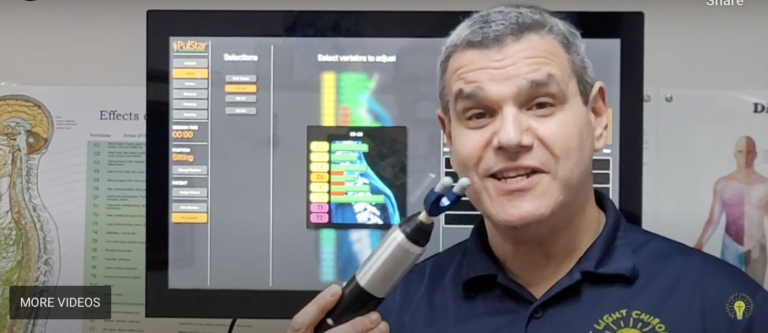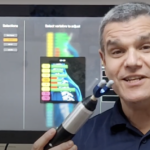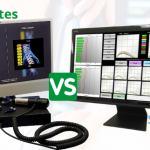 Dr. Steve Walton, owner and primary DC at Lahaina Health Center in Maui, Hawaii, has been using the PulStar™ on all of his patients for more than ten years now. But before purchasing the PulStar and opening his practice in Lahaina, Dr. Walton practiced in the contiguous U.S. and was Chairman of the Technique Department at a chiropractic college, where his stance on instrument adjusting was, “our hands can do more than any gadget.”
Dr. Steve Walton, owner and primary DC at Lahaina Health Center in Maui, Hawaii, has been using the PulStar™ on all of his patients for more than ten years now. But before purchasing the PulStar and opening his practice in Lahaina, Dr. Walton practiced in the contiguous U.S. and was Chairman of the Technique Department at a chiropractic college, where his stance on instrument adjusting was, “our hands can do more than any gadget.”
So why the change of heart? Dr. Walton heard about multiple impulse therapy and spent more than two years carefully researching the techniques and the different devices available on the market before reaching out to us to set up a two-week demo to see how it would work on his patients. A year and a half later, he wrote us this letter and asked us to share it with other chiropractors.
Dear Dr. Evans (Inventor of PulStar System),
You asked if the PulStar “really does what I said it does.” Yes, it does. It’s a very versatile instrument in that it both evaluates and adjusts. The before-and-after CFI scans (Computerized Fixation Imaging) can be used to evaluate any adjusting technique. Or, you can use the instrument to perform the adjustment (like I do). You can adjust anything you want, or have the program calculate segments that need attention (I have it select 5 segments). At first, one of the most exciting things is to see a consistent unique pattern from visit to visit, or consistent patterns for the same patient when evaluated by different doctors. Research has shown inter- and intra- examiner reliability to be very high.
Here are some of my experiences using the instrument for the last year and a half:
John is a 65-year-old male with dual residency in Oregon and Hawaii.
He came into my office complaining of severe low back pain. He wears a 3-inch lift under one leg that was shattered in an old motorcycle injury. I evaluated and adjusted him with the PulStar. At this point, I’d been using it less than one month, and wasn’t particularly skilled.
He came in a few days later and told me, “My back pain is gone!”
I replied, “That’s nice.”
He said, “No, you don’t understand. I’ve had this pain for a year. I’ve been seeing my chiropractor in Hawaii two or three times a week for the last six months. I’m scheduled for surgery when I go back next month. I’m going to call and cancel the surgery.”
He asked, “What do you call that thing? I want to tell my doctor about it.”
He returned to Hawaii, and then came back to Oregon a few months later.
He came in for an adjustment with the PulStar. He’d remained pain-free and continued to rave about the instrument. He told me, “I told my Chiropractor about the PulStar, but he didn’t want to hear it. He said, ‘I don’t like gadgets, and besides I’m too old to learn new tricks.’ I haven’t been back to see him.”
A year and a half later, he’s remained pain-free. He comes in to get “PulStarred” and tells me he hasn’t been back to that Chiropractor; I’m the only one he needs.
♦♦♦
Bill is a large strong older man in his 70s.
As a child he had, and recovered from, polio. Now, later in life, he has what’s called “post-polio syndrome,” a condition where the muscle weakness of the involved leg intermittently returns for no apparent reason (unless you understand Speransky’s neurodystrophy). I’d been adjusting him manually for several years, and he was a “reactive” type patient, who fought me every step of the way. I would inwardly groan when I saw his name on the schedule, knowing that my wrist and shoulder were likely to suffer from the encounter.
When I decided to try the PulStar, he and his wife agreed to enroll in my trial group. (I called many of my regular patients, told them I was trying out a new technology, and offered them a deeply-discounted rate if they would agree to come in at least three visits during the two-week instrument trial period and give me feedback regarding the experience. I had about a dozen patients agree.)
His post-polio had taken a nasty turn. His right leg would give out on him. He fell just getting out of his car. He couldn’t alternate legs going up stairs; he had to use his left leg only.
I gave him three PulStar adjustments, and he had a negative attitude, asking “Is that it? Aren’t you going to crack me?” I could tell that he was thinking, “That thing might be OK for little skinny people, but a guy my size needs a ‘real’ adjustment.”
At the end of the trial, I asked him what he thought. He said, “Well, my wife likes it, but I don’t know.”
I asked him, “How are you feeling? How’s the leg doing?”
He said, “It doesn’t hurt, and it hasn’t given out on me. I have more strength and I can use it to go up stairs again.”
“So, you’re feeling better?”
He hesitated and said, “Yeah, I guess so.”
I asked, “What do you come in here for? To feel better, or for a wrestling match?”
He chuckled and said, “To feel better I guess.”
He has remained a PulStar patient, and his leg hasn’t given him trouble since.
♦♦♦
Amanda is a woman in her 40s. She’s been a regular patient for 12 years or so.
I see her, on average, about twice a month. She’s one of those patients who came in for musculoskeletal problems, but then noticed that her allergies disappeared and she didn’t get sick as often after beginning chiropractic care.
Over the years, I had tried everything I could think of to get an audible release in her upper thoracics—P-A, anterior, massage, muscle stim—I always tried, they never moved.
After I PulStarred her the first time, I said, “Let’s try this,” and did a P-A adjustment at T4/5. It popped and we simultaneously exclaimed, “Wow!”
That’s one of the experiences that convinced me that the PulStar does something unique.
♦♦♦
Annie is a 6-month-old baby girl.
She wasn’t sleeping well (so neither was her mother), and she was constipated. I read a research report about two cases of infants with colic that responded well to the PulStar. The little ones wiggle so much that you can’t really do a scan, and the researcher just used the single-pulse evaluation mode to provide an impulse to each thoracic vertebra. I did the same, on the lowest setting (5lbs) while her mother held her. I also included an impulse to her upper cervicals. After three visits, she was sleeping through the night and no longer constipated.
♦♦♦
Julie is a hard-working woman in her 60s.
She’s small, thin and tight. Over the years, we accumulated a list of things to avoid, like the drop-table (made her feel worse) or the Activator and SOT blocks (didn’t do anything). Her complaint was usually low back pain and intermittent bilateral sciatica. So I had to side posture her low back. I rarely got an audible, and she always fought the adjustment. It was frustrating.
She was one of my trial patients. At the end of the trial, she wanted me to return to manual adjusting.
I couldn’t argue with her: her post-scans consistently looked worse than her pre-scans.
When I first began using the instrument, I was using it with my old mind-set. Anything that looked high on the scan I would try to pound into submission. It was frustrating, because so many patients’ scans looked worse after the adjustment.
Then, I went to a PulStar seminar. Briefly, I learned to be more precise in my scans, to evaluate the scan, not only for stiffness but also for a contouring and smoothing-out of the overall pattern, and to look for a slowing of the rate and increase in compliance as evidence of a good adjustment (before, I used the “auto-stop” function as my cue that the adjustment was as good as it was going to get.) In addition, I was using the PulStar according to the old adage, “It’s better to adjust the patient too hard than not hard enough!” As a result of the seminar, I came back determined to be more precise in my scans and adjust fewer areas with less force.
In general, the patients’ post scans improved dramatically.
Then, Julie came in again. I said, “I’ve just come back from a seminar, and I’ve learned more about the instrument. Let’s try it, OK?”
She was dubious, but agreed. Her post-scan looked so good, I said, “I don’t want to do any more, I might mess things up.”
She left. On her next visit she said, “I don’t know what you did, but that thing worked. My back and legs have been feeling good ever since. Now, what about my headaches?”
She’s remained a PulStar patient, and her back and legs haven’t given her any trouble.
♦♦♦
Sam is a bartender in his 50s.
Six months ago, he reached for a case of sodas on a shelf and felt a pop near his right ischial tuberosity. He thought it was a hamstring tear. The next day, he had severe right sciatic pain radiating below the knee. His leg hurt while standing, sitting, or lying. He went to his M.D., who prescribed muscle relaxers, pain killers and a course of physical therapy.
The drugs didn’t help. He was so non-responsive to PT that the therapist quit the regimen early, telling him she didn’t think she could help. He then went to an acupuncturist 3x a week. After a month, the acupuncturist said, “I don’t think I can help. I don’t think it’s sciatica. Let me know if you find out what the problem is.”
In desperation, he called our office. I noted that he had been in three years earlier for a similar complaint. He hadn’t returned after the initial visit.
During the history and exam I asked him why he hadn’t come to see us first.
He said, “The last time I was in so much pain, and after the adjustment I felt worse. I was afraid to come back, but now I’m desperate. No one can tell me what’s wrong, and no one seems to know what to do about it.”
I said, “Don’t worry, there’s nothing to be afraid of. I think you’ll be pleased with what I’m going to do.” After I finished the exam, I gave him my usual introduction to the PulStar that goes something like this:
“I’ve gone hi-tech. Let me show you what I’m going to do. When you lay face down, I’m going to take this instrument (I hold it up), and touch every vertebra down your back.
(Then I point to a plastic spine.)
“See how many bones there are in the spine? I’m going to touch every one of them, and when I do, it’s going to tap” (then I tap his shoulder with 2 fingers).
“Each time it taps, it will calculate how tight or how loose it is, and as I move down the spine, it will compare it to the one above and the one below, and when I get all the way down to the bottom, it will compare them all to each other and give me a picture over there (I point to the computer screen) of where the problems are.”
(Patient usually says, “Wow!”)
I continue, “But wait, that’s not all: for the adjustment, instead of one big push or twist, I’m going to use this instrument like a gentle jack-hammer, to give multiple impulses (give a few quick taps to patient’s shoulder) to loosen up the tight spots and reposition the vertebra. Then, when I finish with that, I’m going to do another scan of your spine from top to bottom that will give us another picture over there (point to screen) to show us what, if anything, we’ve achieved. Any questions? Let’s get started.”
I assured him, “In any case, it won’t hurt you.”
After the second visit he said, “I think I might be a little better, I don’t know.”
After the fourth visit he said, “I worked my whole shift last night, pain free!
This thing is amazing. I’m telling everyone about it, can I have some cards?”
♦♦♦
To sum up, the PulStar is at least as good as any other system of analysis and adjustment, and better than most. I don’t mean to suggest that it’s perfect, or that it’s for everyone. I still have a few patients that prefer manual adjustment. But 90% of my practice is now instrument, and it has greatly reduced the physical and mental stress of practice. I wish I’d switched 5 or 10 years ago, because it would have saved me a lot of wear and tear. If you are at all curious, I’d love to talk with you about it.









